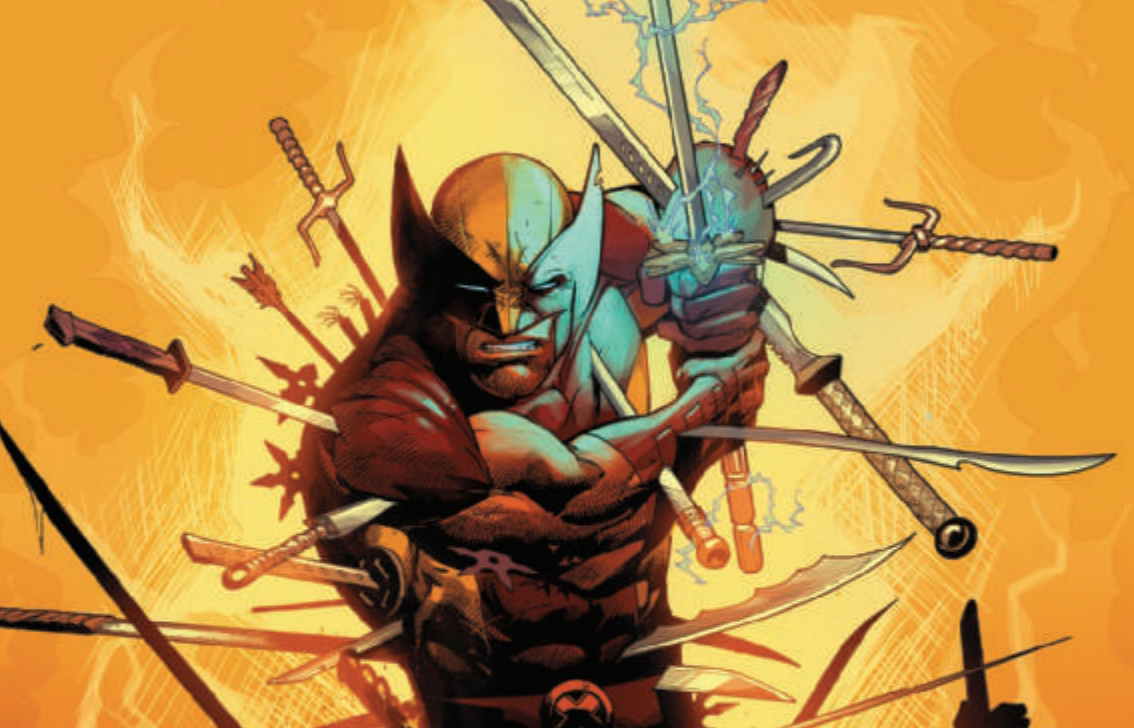Muramasa and Skybreaker
“X of Swords” Chapters 3 and 4
Wolverine #6
X-Force #13
Written by Benjamin Percy
Art by Viktor Bogdanovic
Color art by Matthew Wilson
“X of Swords” Chapter 5
Marauders #13
Written by Vita Ayala
Art by Matteo Lolli
Color art by Edgar Delgado
• These three chapters of X of Swords mark the story’s first narrative gear shift, as the spotlight narrows to a pair of solo stories starring Wolverine and Storm as they go off in pursuit of the swords assigned to them by Saturnyne. There’s a trade-off here – a loss of momentum, but a deeper focus on character and the weight of responsibility bearing down on these two core X-Men members. If the shipping schedule of this crossover were different, these issues might have slowed things down too much, but if we’re burning through the “quest” issues in two or three weeks with a few issues at a time it’s making good time and allowing the reader to invest in Krakoa’s champions before they head off to war.
• The Wolverine and X-Force issues are one story split between two issues, with the X-Force issue being fully a Wolverine comic as the rest of the cast – or even the basic premises of that series – is part of the plot. Benjamin Percy’s plot moves along the X of Swords story while working well as a discrete two-parter in which Wolverine must find a Muramasa blade and discovers he can only do that by literally going to hell to find one. These issues introduce Solem, one of the Swordbearers of Arrako, who is positioned as Wolverine’s new archnemesis in the absence of Sabretooth. Whereas Sabretooth is Wolverine’s opposite number, Solem is more of an inverted version of Wolverine – a warrior with adamantium skin, who embraces aesthetics and hedonism just as Wolverine is more salt-of-the-earth and ascetic.
There’s a certain amount of hubris in aiming to give a major character like Wolverine a new central villain, but given the status quo now it’s sort of necessary. Percy has set up an interesting contrast here, and Solem is immediately charming – an arrogant lothario with poetic sensibilities and a history of causing chaos in Arrako just for the thrill of it. There’s a lot of potential here, if just in exploring a character who is basically a hyper-violent Frasier Crane. (Wolverine, of course, would be the Martin Crane.)
• I particularly like the opening scene of this mini-arc in which Wolverine confronts Krakoa, which very succinctly gets a lot of exposition out of the way while reaffirming Wolverine’s commitment to the promise of the Krakoan nation state and his spirit as a warrior, and showing us that he’s come to distrust the sentient island itself. It’s very true to Wolverine’s nature, but this moment is notable as it’s a rare occasion in which someone has questioned the character of Krakoa and its motives in this era.
• It’s interesting to me that while DC Comics’ current event Death Metal and its predecessor Metal strain to evoke a “heavy metal” aesthetic, X of Swords and these two chapters in particular actually do a better job of that without necessarily advertising it as part of the project. Even aside from all the Arrako elements of the story, just look at those pages in which Wolverine’s adamantium skeleton emerges from the literal fires of hell – you can practically hear the speed metal riffs come through the pages. The fact that these issues are illustrated by Viktor Bogdanovic, whose work looks quite a bit like that of Death Metal artist Greg Capullo, only encourages this comparison.
• The Marauders issue tells the story of Storm going to Wakanda to collect her assigned sword Skybreaker, which is complicated by her fraught relationship with Wakanda royalty since divorcing Black Panther and giving up her crown, and that there is a major taboo of Skybreaker leaving Wakanda soil. Vita Ayala, who makes their Hickman-era X-Men debut here as a guest writer before taking over New Mutants and launching Children of the Atom after this event, has a very good handle on Storm and embraces the complexities and contradictions of her life rather than try to pare down her story. Ayala makes this part of the point of the issue, as Storm seamlessly segues between different aspects of her character – mainstay of the X-Men, goddess, Wakandan royalty, political leader, thief, ex-wife. Aspects of Storm’s identity shift like the weather, but the plot emphasizes that her indomitable will and absolute conviction in doing whatever it takes to do the right thing are immutable characteristics.
• As good as the Marauders issue as a solo Storm issue, it slows some of the momentum of the larger X of Swords story. Whereas the Wolverine and X-Force issues have the same essential narrative purpose as this in terms of focusing on one character and the sacrifice they must make to compete in Saturnyne’s demented tournament, the former story continued to introduce new information about Arrako and its people. Those issues flow more naturally from the previous two chapters, whereas the Marauders issue feels more like a tie-in. It has the vibe of a very good annual, not so much a continuation of the story established by Jonathan Hickman and Tini Howard.
• Text pages in all three of these issues continue the trend of giving background information on each of the realms of Otherworld. The most interesting of these is certainly the page for Mercator, which keeps up the mystery of that realm’s regent, but heavily suggests that it is indeed presided over by Absalon “Mr. M” Mercator, the missing omega level mutant previously mentioned in passing in House of X #1 and the Hickman pages of the Incoming! special. I’m personally very intrigued to see how this character will be presented, and I like this as a potential new context for an underdeveloped and obscure character with godlike powers.






